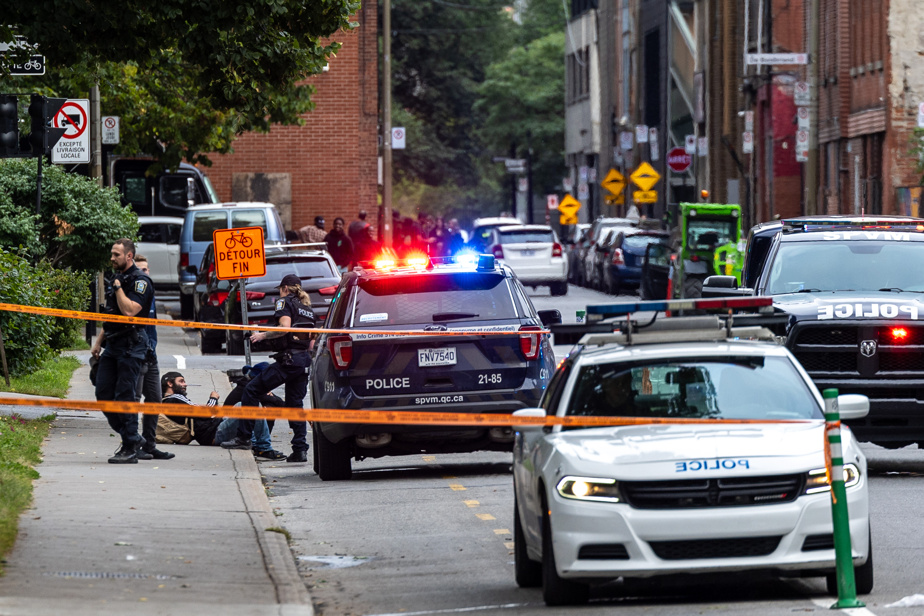Montreal Public Health launched an investigation on Monday into the nine people who had to be transported to hospital on Sunday, in downtown Montreal, for overdoses potentially linked to fentanyl. Quebec, for its part, believes that the situation illustrates the need to “continue to invest in harm reduction”.
In an email to The Pressthe Montreal Regional Public Health Department (DRSP) confirmed that it is “currently investigating” this matter “in order to identify the circumstances of these overdoses and determine with the community the awareness-raising interventions to be enhanced”.
The investigation will be conducted “with several partners in order to properly characterize the situation and the risk for the population”, specified Councilor Luc Fortin, speaking of an “extremely worrying” situation.
“Unfortunately, this is not the first time that a situation like this has occurred, due to the instability and contamination of street drugs in Montreal, particularly by fentanyl, xylazine or nitazenes. We invite users of street drugs, regardless of the mode of consumption, to be careful,” insisted Mr. Fortin.
In addition, the DRSP recommends that consumers attend supervised consumption services, avoid using alone or “all at the same time” in a group. It is also strongly suggested to have naloxone available in sufficient quantity and to decrease the dose of the drug to test its effects, especially if the drug is coming from a new source.
A devastated community
On Sunday, nine people, including seven homeless Indigenous people, were taken to hospital for possible fentanyl-related overdoses. “The community is devastated,” said the general director of Projets Autochtones du Québec (PAQ), Heather Johnston, on Sunday evening. “We have responders who had to return home, everyone is traumatized. »
Sunday’s black series is the most important event of its kind to have hit the Native Projects of Quebec organization, but far from being the first. In November, three of its users had overdosed in front of another shelter managed by PAQ, rue De La Gauchetière, still in downtown Montreal.
In all, seven residents of the Hôtel des Arts, an emergency shelter for homeless Indigenous people located on Saint-Dominique Street, in the Ville-Marie borough, had to be hospitalized at the University Hospital Center de Montréal (CHUM) during the day. Three were in the shelter when responders had to call paramedics to help them.
“It shows the extent of the damage”
In the office of the Minister for Health and Social Services, Lionel Carmant, we are talking about a “very sad day” for Montreal. “Nine human lives lost in a single day is terrible. This demonstrates the extent of the damage that opioids like fentanyl can have on our streets. The fight against overdoses is a problem that we take very seriously,” Mr. Carmant insisted on Monday through his press secretary, Lambert Drainville.
The minister maintains that the issue of opioids has been “on our radar for a long time” with the Ministry of Public Safety. “We are in the second National Overdose Prevention Strategy since 2018. […] It is attached to a budget of 15 million per year,” specifies Mr. Carmant’s entourage.
Quebec also recalls having invested 36.9 million this summer over five years to finance community organizations on the front line of the overdose crisis. “We want to continue to invest in harm reduction and prevention,” the minister’s office continues to insist on this subject.
Focus on the phenomenon in the country
Across Canada, the opioid crisis has taken on increasingly significant proportions in recent years. In July, the Montreal DRSP also said that it had received “a record number of overdose reports” since the beginning of the month.
According to federal Public Health data, Ontario is the province with the highest number of deaths linked to opioid poisoning in Canada, with approximately 2,500 in 2022. This gives a rate of approximately 16.6 deaths per 100,000 population, fourth behind British Columbia (44), Alberta (33) and Saskatchewan (19.7).
Approximately 87% of deaths and 90% of hospitalizations related to poisoning occurred in British Columbia, Alberta and Ontario. Last year there were 7,238 deaths in total, an average of approximately 20 per day.
With 541 deaths linked to this phenomenon last year, Quebec is still far behind this ranking, with a rate of 6.2 deaths per 100,000 inhabitants.
With Vincent Larin
